2010
Internet Society and DEF launched W4C, piloted the first community network in Chanderi in Madhya Pradesh, and trained 10 Barefoot Wireless Engineers.
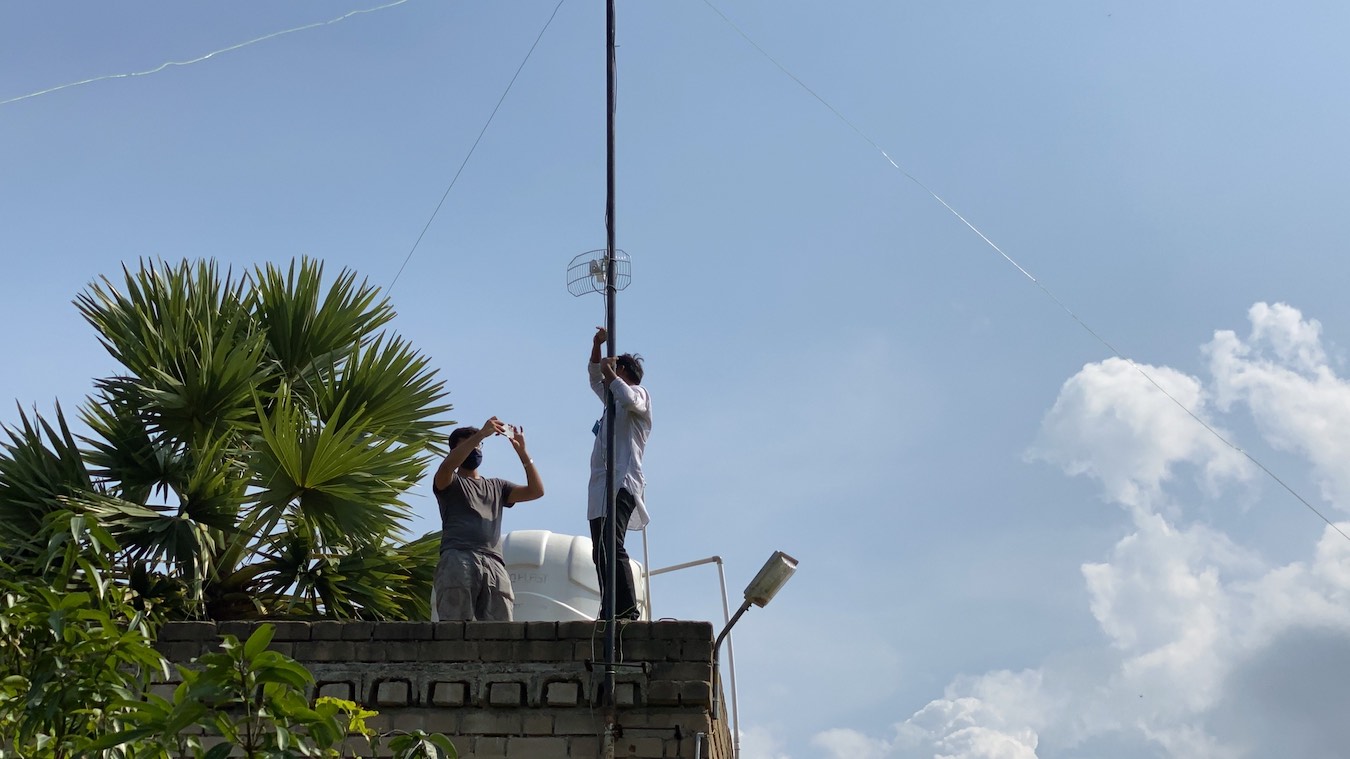
With over half of India’s population unconnected to the Internet, the country is divided into haves and have nots. People who have access tend to be well educated and have higher income, while people who lack it tend to belong to marginalized groups, such as indigenous and tribal communities, women and girls, and those living in hard-to-reach locations. With the Internet a source of educational and economic opportunity, this lack of access can exacerbate socioeconomic inequalities. However, with increasing interconnectedness, local solutions can rapidly scale and bring about global impacts.
Chanderi, a rural town in Madhya Pradesh, was one unconnected area in India struggling to survive while the country modernized. The traditional weaving community, home to about 3,500 families, is famous for its delicate and florid saris, traditional dresses worn by South Asian women.
Indigenous peoples in India comprise an estimated population of 104 million or 8.6% of the national population. Although there are 705 officially recognized.
Although the saris generated an annual revenue of US$10 million, the average income of a Chanderi weaver was only US$50 per month in 2010, primarily due to rampant exploitation by intermediaries. The traditional craft was endangered as younger generations were not interested in it.
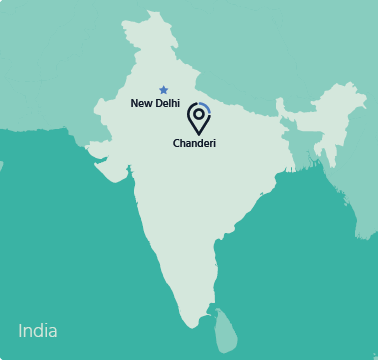
Moreover, a decade ago, 40% of the people in the town were illiterate and none were digitally literate. There were no computers, no ATM facilities, and electricity was supplied for only six hours daily.
But in the past ten years, a lot has changed for this small town. In 2010, the Internet Society and the Digital Empowerment Foundation (DEF) joined forces to implement the Wireless for Communities (W4C) initiative and to establish its first Community network in Chanderi.
Community networks are networks built, managed, and used by local communities. They are last-mile telecommunications infrastructure often built using low-cost Wi-Fi equipment in rural and remote areas—regions commercial Internet service providers do not always find financially attractive. W4C trains communities in the use of equipment and unlicensed spectrum bands so they can connect to the Internet as they wish.
Community networks involve more than just creating infrastructure. They’re centered around communities, who see Internet access as a means to better their lives. Access can also improve the lives of poor and marginalized groups. For Chanderi, once an Internet connection was established, W4C focused on empowering weavers to digitally preserve traditional sari design, research and create new designs, enhance production efficiency, and increase income by enabling direct communication with buyers instead of relying on intermediaries.
W4C also connected schools, public health facilities, and local government offices in the town to improve educational, health, and government services. The town’s public health center now has a telehealth facility that enables video consultations with doctors at district hospitals.
Chanderi was the first of many other community networks deployed in India and other countries by the W4C initiative.
After W4C surveyed and mapped connectivity gaps in India—as well as where there were opportunities to bring about impactful change—they selected Chanderi as the first community network site. Chanderi faced complex challenges, but there were opportunities to improve the town’s livelihood and to preserve its rich heritage.
DEF had previously built rapport and trust with the community by establishing the Chanderi Weavers ICT Resource Center, which created demand for access to information through the Internet. This is a physical center that became the base for installing the relay station from which the Wi-Fi signals are transmitted to five access nodes across town.
Training was a key component of W4C, and ten enthusiastic local young people were trained to install and maintain the wireless network in Chanderi. W4C found that capacity building and community empowerment are crucial to a community network. “Because what we learned quickly is that there are no wireless engineers willing to go to remote places to set up Internet connectivity on a pro bono basis,” says Osama Manzar, Founder and Director of DEF.
Once connected, W4C worked with the community to revive the handloom weaving industry. They enabled weavers to create new and attractive handloom designs through access to ideas and know-how online. Chanderi’s handloom designs and techniques—which date back to the 13th century—are also being digitally preserved.
Both traditional and new handloom designs have been digitalized and stored in a repository, and there are now about 30,000 designs that can be accessed by weavers in Chanderi. It’s significantly reduced production time—and more than doubled weavers’ income.
The Internet has also broadened the market through e-commerce and social media sites. Weavers no longer have to rely on intermediaries and can connect directly with buyers. The e-commerce website Chanderiyaan launched in 2011, which allows them to directly sell their products online.
Internet connectivity benefited not only the weavers, but the entire community. Internet access propelled residents to build their digital skills. Connected schools, teachers, and tutors started organizing digital literacy and digital skills training for students and youth. Shops, hotels, and restaurants are promoting Chanderi as a tourist destination, transforming it into a thriving community.
Today, at least one person in every household of Chanderi is digitally literate.
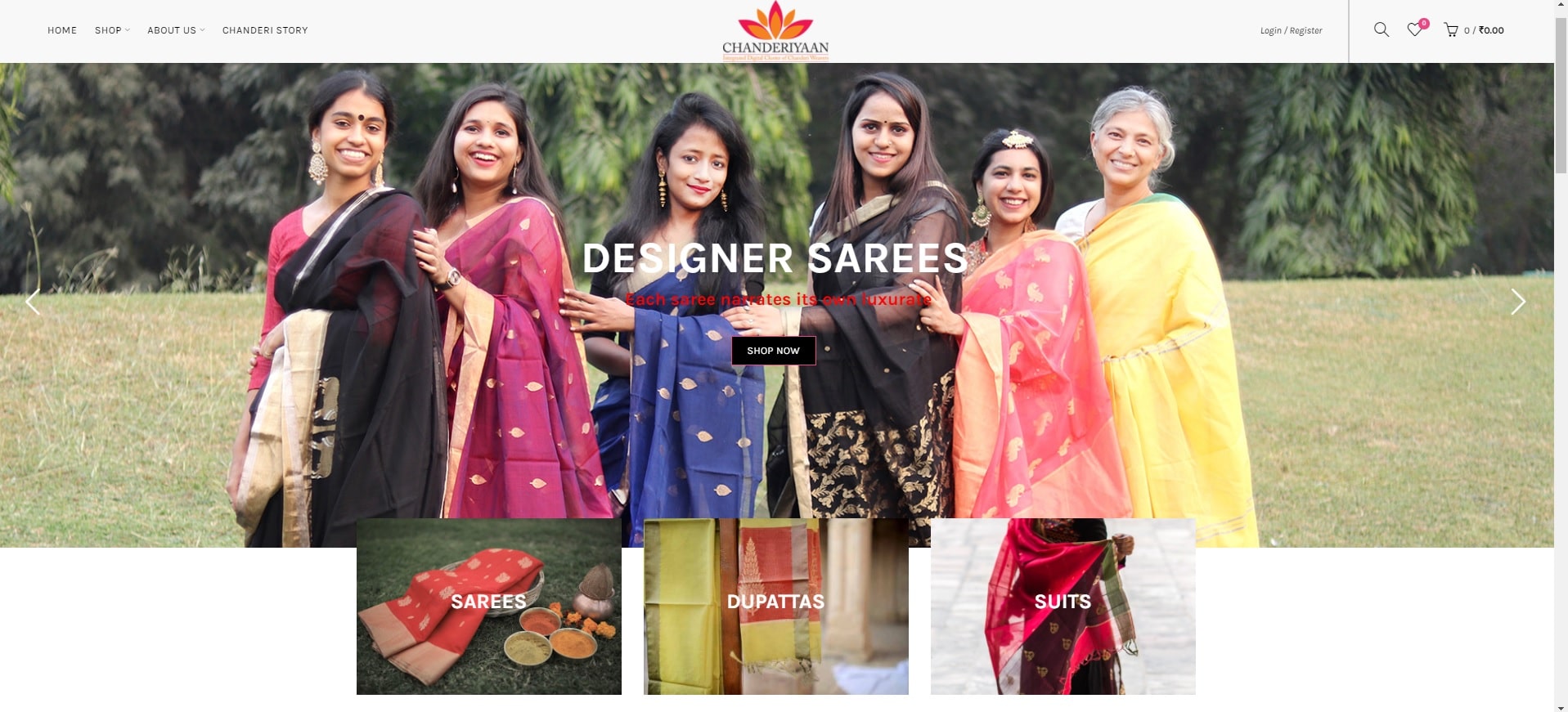
Mudassir Ansari is from a weaving family in Chanderi. In 2010, he participated in the first W4C wireless networking training. Since then, he’s trained over 2,500 people and has helped established many community networks.
“W4C changed my life. I opened the first cyber café in Chanderi after participating in the training, which is also a learning center for youth,” says Mudassir.
His latest mission: setting up a community network during the COVID-19 pandemic in the tribal village of Sittilingi, in the Dharmapuri district of Tamil Nadu. “It was very challenging to establish connectivity there due to the hilly and forest terrain and irregular electricity supply, but we succeeded after eight days, after trying different equipment and techniques,” says Mudassir.
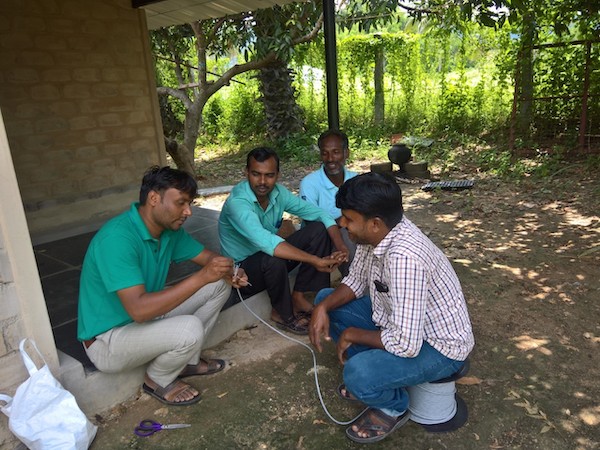
It started with an idea. The award-winning W4C initiative was the first community network project of the Internet Society. Since then it became the basis for a global program, spanning over 30 countries with many global partners.
Our efforts have led to hundreds of networks being inspired and deployed in India and globally, providing access to tens of thousands of people.”
Following the success in Chanderi, W4C quickly expanded across India. In 2011, three communities were connected: Tura in Meghalaya, and Baran and Tilonia in Rajasthan. In 2012, three more communities were connected: Giridih in Jharkhand, Mandla in Madhya Pradesh, and Nangaon in North Tripura.
The ten local youth who were trained to install and maintain the wireless network in Chanderi became known as Barefoot Wireless Engineers. Four of them were instrumental in establishing other new community networks. They work together with DEF to train new batches of Barefoot Wireless Engineers in communities across the world.
This “train-the-trainers” model enables communities to not only sustain and grow their own community network, but also helps people in other communities establish new networks. W4C has successfully used this model to deploy over 250 community networks in 68 districts in 20 states. Most of these community networks are in rural and remote regions of India, inhabited by marginalized groups in harsh terrains and climates, with lack of access to electricity.
Mukesh Chaudhry once had to trek for hours up mountain ranges in Rajasthan to repair a connection. He had to wake before sunrise to start the journey, but he feels the work is worth it. Based in Tilonia, Mukesh travels around the country offering his expertise in deploying solar-powered community networks to areas without electricity. Getting to these remote areas is one of the many challenges of Barefoot Wireless Engineers. Another challenge is improving the durability of network equipment in harsh conditions, and ensuring they do not get damaged or stolen.
Mukesh was trained as a Barefoot Wireless Engineer in New Delhi and Guna, and has been involved in bringing the Internet to the remotest parts of the country, including in the Little Rann of Kutch. There he connected 30 schools that provide education to the Agariyas. This unrecognized minority community brave intense heat and harsh conditions to produce a large proportion of India’s salt, but they live in poverty as a result.
Working as a Barefoot Wireless Engineer, and as a young father of two children, he finds fulfilment in enabling education. “Every child deserves to learn.” He is now working to equip night schools in Tilonia with solar-powered lighting and Internet connectivity. Once complete, children who need to help their parents with work during the day can learn at night.
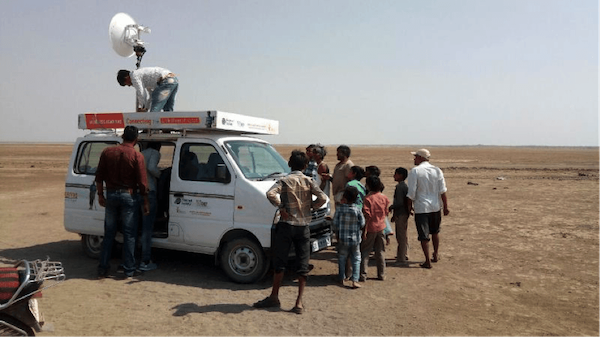
Since the start of W4C in 2010, many other organizations including the Alliance for Affordable Internet (A4AI), APNIC Foundation, Association for Progressive Communications, Commonwealth of Learning, and Ford Foundation have come on board and contributed to the initiative. Training for Barefoot Wireless Engineers has been delivered in Bangladesh, Bhutan, and parts of Africa as well.
Over time, to support the training of Barefoot Wireless Engineers, W4C established a training center in Guna, located in Madhya Pradesh. They’ve also developed a training course with simple, easy-to-understand guidelines and video tutorials on how to install and maintain community networks. Generally, technical manuals for setting up wireless networks are not easy to understand. Tailored training, including for those who are illiterate, is important.
W4C’s emphasis on capacity building and community empowerment, and the support from various partner organizations to establish new community networks across India, has given rise to a growing group of Barefoot Wireless Engineers. With their skills and passion, they can be mobilized to support existing networks and build new ones.
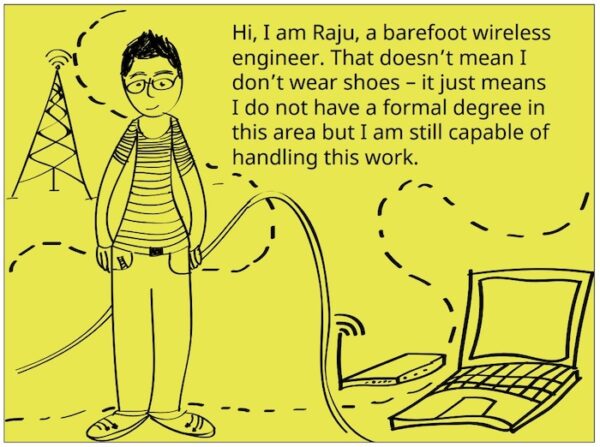
Barefoot Wireless Engineers in India are from rural unserved and underserved areas, often from minority and tribal communities, and have limited education. They have been trained by other more experienced Barefoot Wireless Engineers to install and operate community networks in their villages. Today, there are about 350 of them helping other villages establish their own networks and providing training to grow networks in India and other countries.
Anyone can install community networks, and people are doing it. Villages across rural India are now connected and running on their own, with the residents in charge of upkeep, tech, and maintenance.
Using the experience of delivering wireless networking training in six more communities after the success in Chanderi, the DEF, with support from the Internet Society, developed a training manual for Barefoot Wireless Engineers in 2012. Through the years, they continued to improve it as more people were trained and the number of Barefoot Wireless Engineers grew.
In 2018, with support from the Commonwealth of Learning, the training materials were collated and improved, and a Course for Barefoot Wireless Engineers was developed with two modules:
These modules are made for self-paced learning by individuals, or as a resource in a training course. Mindful of the fact that those interested in becoming Barefoot Wireless Engineers may be illiterate and unconnected, the course is made freely available both offline and online (on web and mobile) at http://lms.defindia.org, using the open-source learning management system Moodle. It contains a full set of video tutorials and local stories (also available on YouTube).
The course is intended to be used and shared freely by trainers and those working in telecenters, such as cyber cafés, community media organizations, and non-governmental organizations.
The Barefoot Wireless Engineers note that technologies continue to advance. Situations change rapidly, so the course needs to be regularly updated.
Also, as India has more than 19,500 languages or dialects, ensuring accurate translation of the technical details is an ongoing challenge faced by Barefoot Wireless Engineers when they conduct training.
Naghma Khan, from Baran, joined DEF’s digital literacy program several years ago. It was the first time she came across a computer. “I was so excited […] my hands were shaking.” Soon she enrolled in the training course for Barefoot Wireless Engineers. But her journey was far from easy, due to opposition from her community.
Naghma always wanted to be an engineer, but she had to drop out of school due to financial constraints. Her father is a rickshaw driver who struggled to secure food for the family.
“People used to tell my mother that she should not allow her daughter to study and work with men,” says Naghma. But she persevered, and along with her work as a Barefoot Wireless Engineer, she went back to school and received a degree in social science.
Today, she is the person the community turns to when the Internet is down. She has trained many people in her locality and is appreciated for bringing Internet to the village. Parents are even asking Naghma to train their girls. Her dream of becoming an engineer has come true after all. She hopes the Internet will enable all women and girls to overcome barriers and achieve independence.
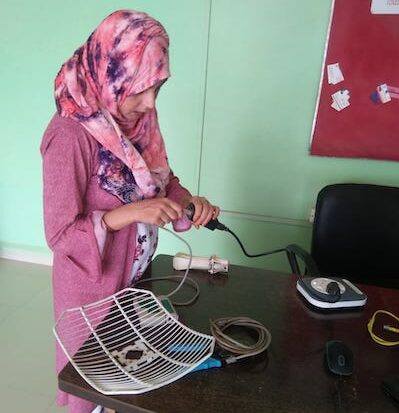
With the newly-developed multimedia Course for Barefoot Wireless Engineers, over 60 women were trained as Barefoot Wireless Engineers in Wanaparthy (Telegana), Protovillage (Andhra Pradesh), and Pathardi (Maharashtra). The course was also conducted in Africa, training 54 Barefoot Wireless Engineers in Nigeria and Uganda, half of them women.
Previously, W4C also organized trainings for women, such as the Solar Women Wireless Engineers for Entrepreneurship and Empowerment Program. This course trained women not only in wireless networking, but also in using solar energy to power wireless networks in areas lacking electricity.
In Chanderi, Qaisar Qureshi was the first woman trained as a Barefoot Wireless Engineer. Since her training, she has been actively involved in expanding the community network in her town.
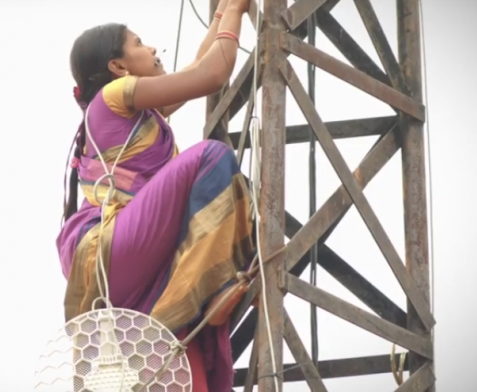
View the video of Talaria Amruta, one of the first Barefoot Women Wireless Engineers in Andhra Pradesh, fearlessly climbing the network tower.
These trainings for women have contributed to their empowerment, and a cultural shift in communities’ perception of women’s role in society. The Barefoot Women Wireless Engineers have become role models for women and girls in their communities. It underscores how upskilling in technology and bridging the digital divide can improve the lives and livelihoods of marginalized groups.
The biggest achievement is that people are not just acting as consumers of information. They are sharing knowledge. They are talking about their rights, about access to services, about democracy. You see it the most with the women in the community. India is still a very patriarchal society, but in our programs, women play a key role. In many of these communities, the men migrate to other parts of the country for work, but the women usually stay put. As a result, they are often in charge of the community access points and the computers. They are the keepers of information, and having that role gives them more leverage to make decisions in their households and communities.”
Fauziya Naseem, from Bihar, has trained dozens of women and men throughout the country in wireless networking. Initially a Barefoot Wireless Engineer, she joined DEF as a Senior Network Engineer in 2015. She also oversees community networks in the Guna and Shivpuri districts of Madhya Pradesh for scheduled castes and tribes.
“Stepping outside the home and traveling is still a challenge for women. Paternalistic attitudes are prevalent, and women still need permission to go outside. Men of our society decide what women should do, what kind of education we should get. These patriarchal attitudes have deep roots in our society. Not all women we trained were able to become Barefoot Wireless Engineers but some succeeded, which gives me hope. Internet connectivity is democratizing society and I hope it will shake the deep-rooted patriarchy and paternalistic attitudes of our society,” she says.
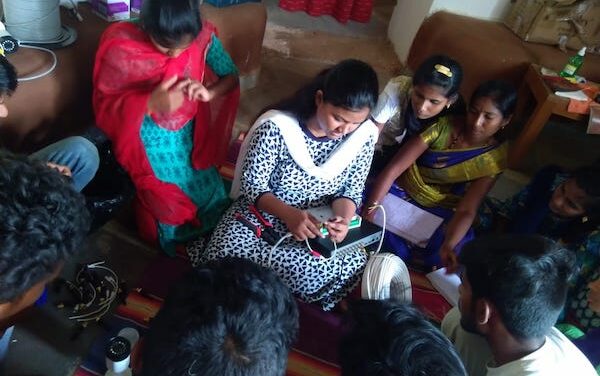
Besides providing connectivity, promoting the use of the Internet in these rural, remote communities is another key strategy for sustaining and growing community networks. Often, unconnected communities do not immediately recognize the value of the Internet. The W4C is therefore also nurturing a group of trained entrepreneurs, including women entrepreneurs, to promote the use of digital services. With the training provided through support from various partners, including Nokia, many have successfully established digital centers and micro-enterprises. Today, there are 850 of these centers throughout India. There are plans for the establishment of 500 more by the end of the 2021, as education, health, financial and other services move online during the COVID-19 pandemic.
As the world embraces greater access to information and services online, the excluded individuals are being further excluded. We cannot solely depend on telcos to connect the 70% of the population that is yet to access the Internet.”
These digital centers and micro-enterprises have been critical in bringing people online who didn’t feel the need or have the know-how to do so. They provide access to relevant and timely information, including COVID-19 resources, support marginalized groups in applying for and receiving welfare benefits, facilitate consultations with doctors through telehealth platforms, and enable selling and buying products through e-commerce and social media platforms. By demonstrating the benefits of Internet connectivity, these digital centers and micro-enterprises help to sustain and grow community networks.
In addition to capacity building, W4C organizes an annual Community Network Exchange – Asia Pacific to share knowledge and experience with other countries on installing and operating community networks. This provides Barefoot Wireless Engineers with the opportunity to learn from other initiatives, and engage in broader policy and regulatory discussions, such as expansion of the range of spectrum frequencies for community networks, the sharing of spectrum and infrastructure, and community networks’ access to Universal Service Funds.
Installation and maintenance of community networks has been a major challenge during the COVID-19 lockdown. Due to travel restrictions, troubleshooting often has to be done by phone. The Barefoot Wireless Engineers have worked hard to provide Internet connectivity to unconnected villages during the pandemic, ensuring that children can continue learning, and villagers are able to maintain their livelihood and access essential services. The Barefoot Wireless Engineers are in regular contact via messaging and video-calling apps to support each other, help solve problems, and share experiences.
Some of the Barefoot Wireless Engineers, together with entrepreneurs, joined forces to support DEF’s COVID-19 Digital Emergency Relief Program 2.0. They distributed masks and sanitizers, health equipment, and essential supplies; disseminated information and mitigated inaccurate information about COVID-19; and assisted villagers access government aid, telehealth services, and vaccine registration.
Internet connectivity will become more important as services move online. The Course for Barefoot Wireless Engineer will continue to be updated and adapted to suit the needs of different communities. W4C will prioritize the training of women as either Barefoot Wireless Engineers to install wireless networks, or as entrepreneurs in creating micro-enterprises to promote the relevance and use of digital services. The W4C initiative, together with the growing group of Barefoot Wireless Engineers, will continue to reach out to the most remote corners of India to provide last-mile wireless connectivity. From the town of Chanderi to over 250 communities across India, they want to make sure no one is left behind.
2010
Internet Society and DEF launched W4C, piloted the first community network in Chanderi in Madhya Pradesh, and trained 10 Barefoot Wireless Engineers.
2011
Expanded to three communities: Tura in Meghalaya, and Baran and Tilonia in Rajasthan.
2011
Delivered Wireless Networking Training of Trainers Program in Bangladesh and Bhutan.
2012
Expanded to three more communities: Giridih in Jharkhand, Mandla in Madhya Pradesh, and Nangaon in North Tripura, training a total of about 30 Barefoot Wireless Engineers.
2012
Published first training manual for Barefoot Wireless Engineers.
2013
Established a large community network in Guna in Madhya Pradesh, with support from the Ford Foundation.
2014
Established over 150 access points throughout India.
2016
Established over 200 access points throughout India.
2016
Established Training Center for Barefoot Wireless Engineers in Guna.
2017
Developed a self-learning manual for Barefoot Wireless Engineers.
2017
Launched the annual Community Network Exchange – Asia Pacific to exchange experiences, technologies, and best practices.
2018
Incorporated in Barefoot Wireless Engineers training the use of solar energy to power community networks in areas lacking access to electricity.
2018
Established over 250 community networks throughout India.
2018
Collated and improved training materials to develop the Course for Barefoot Wireless Engineers with support from the Commonwealth of Learning.
2019
Trained over 60 women in the Course for Barefoot Wireless Engineers in Wanaparthy, Protovillage, and Pathardi with support from the Association for Progressive Communications.
2019
Conducted training to establish community networks in Nigeria and Uganda with support from the Commonwealth of Learning.
2020
Established community networks in remote parts of Andhra Pradesh, Haryana, and Tamil Nadu to fight the impact of COVID-19.
2021
Trained a total of over 350 Barefoot Wireless Engineers.
All photos are courtesy of Digital Empowerment Foundation (DEF).